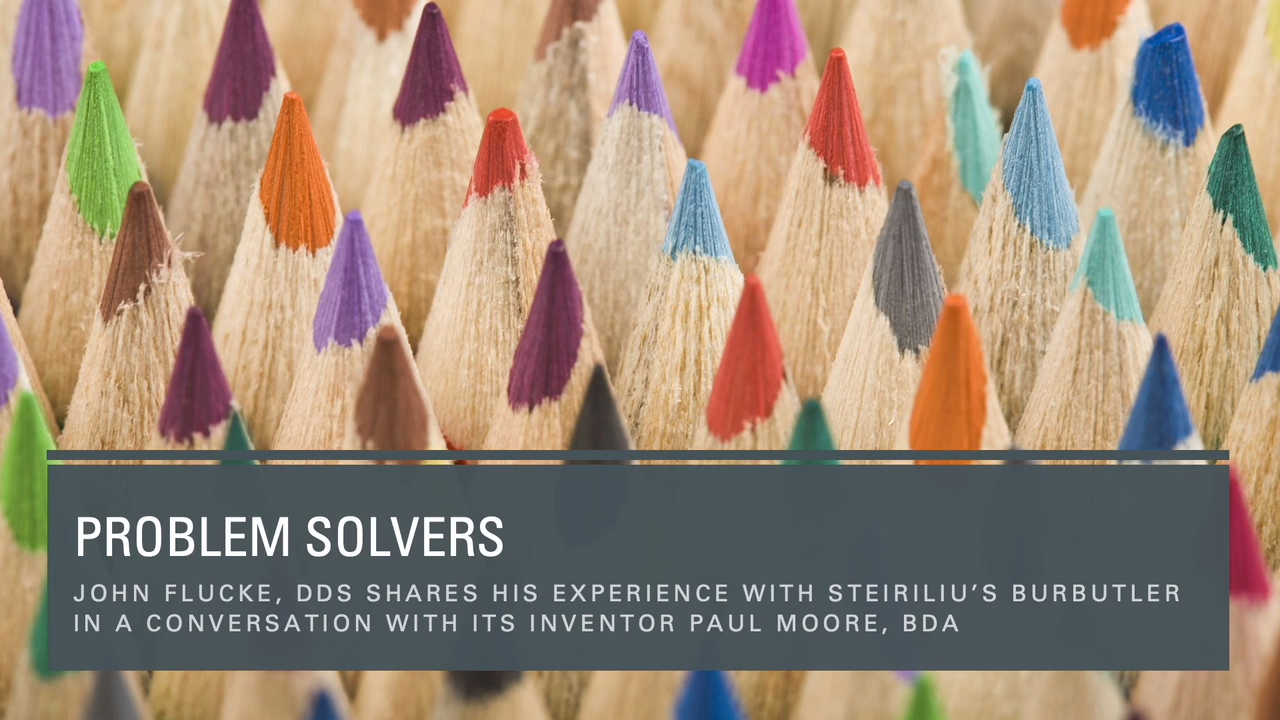Problem Solvers: BurButler bur blocks from Steiriliu
Dental Products Report Chief Clinical Editor John Flucke, DDS, shares his experience with Steiriliu's BurButler bur blocks with one of the product's inventors, Paul Moore, BDA. [5 Minutes]

For a look at other innovative organization and sterilization solutions check out Novel Organization Systems Drive Operatory Efficiency from the January 2022 issue of Dental Products Report®.
Video Transcript:
John Flucke, DDS: Before BurButler, we were using anodized, aluminum blocks with the little, you know, tip back lids. And those worked okay. Unfortunately, over time, as they get autoclaved, the colors fade, they get scratched, they don't, they don't look real good. And the other thing that's a limitation on them is the lids themselves. And it doesn't matter who makes them—because I've got a lot of these from different companies where I've actually bought a kit that came with the block—all of them in a fairly short amount of time, and I don't know if it's corrosion or what it is, but the lids just don't open right anymore, you really have to fight to get them open, you've got a fight to get them close, some of them as you're fighting to get them open will actually pop, and you end up with two pieces, a lid and a block. The other thing is they don't, they don't shut and stay shut. So heaven forbid, if you do drop one on the floor, the lid pops open burs go everywhere. To contrast that with the BurButler, we've been using them for at least six months now. They look the same as the day I took them out of the box. They work tremendously well. You can take them and turn them upside down, burs stay put. If you drop them, same thing. Nothing comes out, you just pick up the BurButler and go on. There's no corrosion factor. There's no nothing. And quite honestly, when I first used it, I can't believe that somebody hadn't thought of this before. You know, it's not like somebody magically discovered this medical grade, you know, material that you can use for this. It has been around for a while. But the actual process is genius. I mean, it's something that I think everybody should have in their kits. It just makes you more organized and more efficient.
Paul Moore, DBA: Excellent. Yeah. i What was your first reaction when you turn it upside down?
JF: I was thrilled. Honestly, I smiled. Because I thought, you know, I humorously say in dentistry, the only thing that doesn't hit the floor is the floor itself. Everything gets dropped. I don't care if it's curing light, an instrument, an entire kit, a bur block. And normally, you know, when a bur block hits, everything goes off in every direction. And it's not like these are easy things to find. And knowing that I can actually take it, turn it upside down, having that and knowing that those burs aren't going anywhere. And that, you know, there was a shock absorber so that you're not taking a risk on if you happen to have a wooden floor, or I work on heat sealed vinyl, but you can drop things if they come down at you know, on a corner, you can you know, mark the floor, chip the floor. Doesn't happen with the burButler. The BurButler is genius. It is simplicity quite honestly.
PM: Yeah, there's no moving parts on it. Right? Like, yeah.
JF: It doesn't Ah, it looks the same. After I would venture to say hundreds of autoclave cycles at this point, it looks like I just opened the package yesterday.
PM: Yeah, no, we would expect. I mean, we've been using for eight years in the practice, and I'm still using the same ones. There might be a slight fading of color over that length of time, but that's about it. And how do you integrate them into your practice?
JF: So we took them, we we use the different colors for different tray setups, so that if they by chance, get separated, we know that blue goes with operative, you know, that sort of thing. So the color coding really helps as well, helps you stay organized.
PM: What would you say to someone who's in a practice where they still using the old systems?
JF: Yeah. You know, it's one of those things where you don't know what you've got until you have it. Oftentimes with with new processes and new things in your office, you don't realize how inefficient that old way is. Because that's how we've always done it. You just accept the inefficiencies. But when that's taken away from you, and you're confronted with a new way of doing things, that is easy and makes things better and more organized, there's no way you go back to those anodized aluminum blocks ever.